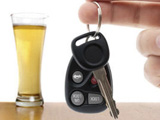|
|
TODAY.AZ / Weird / Interesting
Buzz Kills: No amount of alcohol safe to drive
21 June 2011 [18:06] - TODAY.AZ
 In the United States, the blood-alcohol limit may be 0.08 percent, but no amount of alcohol seems to be safe for driving, according to a University of California, San Diego sociologist. A study led by David Phillips and published in the journal Addiction finds that blood-alcohol levels well below the U.S. legal limit are associated with incapacitating injury and death.
In the United States, the blood-alcohol limit may be 0.08 percent, but no amount of alcohol seems to be safe for driving, according to a University of California, San Diego sociologist. A study led by David Phillips and published in the journal Addiction finds that blood-alcohol levels well below the U.S. legal limit are associated with incapacitating injury and death.Phillips, with coauthor Kimberly M. Brewer, also of UC San Diego, examined official data from the Fatality Analysis Reporting System (FARS). This dataset includes information on all persons in the U.S. who were involved in fatal car accidents -- 1,495,667 people in the years 1994 to 2008. The researchers used FARS because it is nationally comprehensive, covering all U.S. counties, all days of the week and all times of day, and, perhaps most important, reports on blood-alcohol content in increments of 0.01.
All the accidents included in FARS are, by definition, severe. But the authors looked at different levels of accident severity by examining the ratio of severe injuries to minor ones.
"Accidents are 36.6 percent more severe even when alcohol was barely detectable in a driver's blood," Phillips said. Even with a BAC of 0.01, Phillips and Brewer write, there are 4.33 serious injuries for every non-serious injury versus 3.17 for sober drivers.
There are at least three mechanisms that help to explain this finding, Phillips said: "Compared with sober drivers, buzzed drivers are more likely to speed, more likely to be improperly seat-belted and more likely to drive the striking vehicle, all of which are associated with greater severity."
There also seems to be a strong "dose-response" relationship between all these factors, the authors write: The greater the blood-alcohol content, the greater the average speed of the driver and the greater the severity of the accident, for example.
The findings persist even when such potentially confounding variables as inattention and fatigue are excluded from the analysis.
In general, accident severity is significantly higher on weekends, between 8 p.m. and 4 a.m. and in the summer months, June through August. But when the researchers standardized for day of the week, for time of day and for month, the relationship between BAC and more dangerous car accidents also persisted.
"Up till now, BAC limits have been determined not only by rational considerations and by empirical findings but also by political and cultural factors," Phillips said, citing as evidence that the U.S. national standard of 0.08 is relatively recent and that BAC limits vary greatly by country. In Germany, the limit is 0.05; in Japan, 0.03; and in Sweden, 0.02.
"We hope that our study might influence not only U.S. legislators, but also foreign legislators, in providing empirical evidence for lowering the legal BAC even more," Phillips said. "Doing so is very likely to reduce incapacitating injuries and to save lives."
/Science Daily/
URL: http://www.today.az/news/interesting/88755.html
 Print version
Print version
Views: 1975
Connect with us. Get latest news and updates.
See Also
- 19 February 2025 [22:20]
Visa and Mastercard can return to Russia, but with restrictions - 05 February 2025 [19:41]
Japan plans to negotiate with Trump to increase LNG imports from United States - 23 January 2025 [23:20]
Dubai once again named cleanest city in the world - 06 December 2024 [22:20]
Are scented candles harmful to health? - 23 November 2024 [14:11]
Magnitude 4.5 earthquake hits Azerbaijan's Lachin - 20 November 2024 [23:30]
Launch vehicle with prototype of Starship made its sixth test flight - 27 October 2024 [09:00]
Fuel prices expected to rise in Sweden - 24 October 2024 [19:14]
Turkiye strikes terror targets in Iraq and Syria - 23 October 2024 [23:46]
Kazakhstan supplied almost entire volume of oil planned for 2024 to Germany in 9 months - 23 October 2024 [22:17]
Taiwan reported passage of Chinese Navy aircraft carrier near island
Most Popular
 Separatists & Pashinyan - the farce continues
Separatists & Pashinyan - the farce continues
 4SIM signs MoUs with Chinese institutions to boost cooperation in green and industrial technologies
4SIM signs MoUs with Chinese institutions to boost cooperation in green and industrial technologies
 Antalya Diplomacy Forum becomes center of global dialogue
Antalya Diplomacy Forum becomes center of global dialogue
 A fat, nosy and bald hint that Armenia will remove claims against Azerbaijan from the Constitution
A fat, nosy and bald hint that Armenia will remove claims against Azerbaijan from the Constitution
 Collapse of "macaronism": Resignation of the "grey cardinal" of France may cause a chain reaction
Collapse of "macaronism": Resignation of the "grey cardinal" of France may cause a chain reaction
 Foreign diplomats tour liberated cities of Khankendi and Shusha
Foreign diplomats tour liberated cities of Khankendi and Shusha
 Paris hosts debut of Azerbaijan’s first AI art “Shusha”
Paris hosts debut of Azerbaijan’s first AI art “Shusha”
